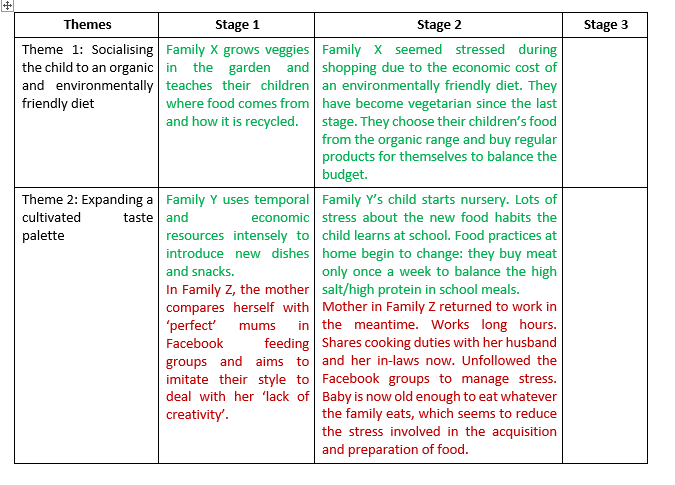 Today’s guest post is written by Dr Irmak Karademir Hazır, Senior Lecturer in Sociology at the Department of Social Sciences, Oxford Brookes University, UK. In her post, Irmak outlines the trajectory approach she is currently using in her ethnographic and longitudinal research (BA/Leverhulme SRG) looking at the practices of foodwork (eating, cooking and feeding) in families with small children across different social classes. Irmak’s research focuses on class cultures, embodiment, cultural tastes and hierarchies. She is also interested in using and teaching quantitative and qualitative research methods and has used mixed methods designs with various combinations in her research so far (e.g. Cultural Distinctions, Generations and Change).
Today’s guest post is written by Dr Irmak Karademir Hazır, Senior Lecturer in Sociology at the Department of Social Sciences, Oxford Brookes University, UK. In her post, Irmak outlines the trajectory approach she is currently using in her ethnographic and longitudinal research (BA/Leverhulme SRG) looking at the practices of foodwork (eating, cooking and feeding) in families with small children across different social classes. Irmak’s research focuses on class cultures, embodiment, cultural tastes and hierarchies. She is also interested in using and teaching quantitative and qualitative research methods and has used mixed methods designs with various combinations in her research so far (e.g. Cultural Distinctions, Generations and Change).
Tracing changes in notions and practices of child feeding: a trajectory approach to qualitative longitudinal research
I am using qualitative longitudinal research (QLR) to explore how families with young children (1.5 to 4 years old) organise and negotiate eating/feeding practices at home and beyond. The families I work with have different levels of economic, cultural, and temporal resources at their disposal and they all try to manage them to maintain an emotionally and nutritionally rewarding food routine. My interviews have generated data that could be very interesting for a cross-sectional analysis, demonstrating different notions of healthy eating/feeding and class-cultural distinctions in food socialisation. However, I am more interested in the element of change in this particular study. In what ways do a variety of factors (e.g. parents’ return to work; arrival of a new sibling; information received from professionals, social media, or the baby food industry) shape the period in which young children embody new food habits? What happens to adults’ eating practices when they have new family members (e.g. changes in the gender division of labour; experiences of commensality; acquisition of new cooking practices)? How do parents negotiate their feeding principles as children grow? To understand how these processes unfold in time, I use a trajectory approach in my analysis.
Since I visit my families every six months over two years, the data collection period of this study can be considered short for QLR. However, given that the topic is concerned with a very dynamic moment in couples’ lives, the distance between the time points works well. Inspired by Grossoehme and Lipstein’s approach (2016) to data analysis in medical QLR, I chose trajectory analysis as an analytical approach, as opposed to recurrent cross-sectional analysis. Trajectory analysis prioritises unpacking how an experience changes over time as well as the factors surrounding the case, rather than solely identifying the differences between two time points. It is advised that researchers use time-ordered displays (sequential matrices), which would permit an understanding of ‘what led to what’. To be able to employ trajectory analysis, the data collected from each stage should be coded individually first. After each stage, the themes are put into a matrix to show stability and change with time. As the example below shows, changes such as children starting school or a family’s decision to become vegetarian between two stages will influence their feeding principles, routines, and emotional responses. When the coding of three stages is completed, the matrix will show the trajectory of food parenting experiences (from introduction of solids to school age) around the key themes identified.
period of this study can be considered short for QLR. However, given that the topic is concerned with a very dynamic moment in couples’ lives, the distance between the time points works well. Inspired by Grossoehme and Lipstein’s approach (2016) to data analysis in medical QLR, I chose trajectory analysis as an analytical approach, as opposed to recurrent cross-sectional analysis. Trajectory analysis prioritises unpacking how an experience changes over time as well as the factors surrounding the case, rather than solely identifying the differences between two time points. It is advised that researchers use time-ordered displays (sequential matrices), which would permit an understanding of ‘what led to what’. To be able to employ trajectory analysis, the data collected from each stage should be coded individually first. After each stage, the themes are put into a matrix to show stability and change with time. As the example below shows, changes such as children starting school or a family’s decision to become vegetarian between two stages will influence their feeding principles, routines, and emotional responses. When the coding of three stages is completed, the matrix will show the trajectory of food parenting experiences (from introduction of solids to school age) around the key themes identified.
What makes my analysis different from other QLR that I have read so far is that each stage of data collection in my fieldwork focuses on a different aspect of food practice (provision, preparation, management), and this, I think, complicates the analysis. The first stage of data collection took place in the homes of families, where we prepared food and in most cases ate together. In the analysis of this stage, I looked for themes explaining families’ notions of good feeding/eating and how they organised their resources to enact and transfer these routines to their children. In the second stage, we went out food shopping together and talked about their preferences as I observed their food provisioning routines. Thus, each disposition that I identified in the analysis corresponded to a different set of practices in each stage, related to the provision, preparation, or emotional management of food work. As the example below shows, the practice extracted from the first time point to demonstrate a theme is usually related to preparation and cooking, whereas for the second time point the examples come from the shopping experience (i.e. provisioning). However, all examples are linked to the theme identified and show the trajectory of the dispositions/practices.
Thomson (2007) suggests that there are two aspects of longitudinal qualitative data analysis: the first is the longitudinal aspect of individual cases and the second is cross-sectional differences of structural context. She argues that in the analysis, researchers should develop case histories and then bring them into conversation with each other by comparing their various themes. Since I am interested in how social class shapes foodwork/feeding work in families, I decided to adjust the matrix to help me see the second aspect that Thompson refers to: cross-sectional variations. To achieve this, I decided to colour-code each entry to indicate the level of economic and cultural resources of the family interviewed (e.g. green indicates that the family has high cultural capital/moderate economic capital). At the end of the three stages, the matrix will not only demonstrate how events unfolded for each individual family but also how similar processes are lived by families from different social classes.
Like in the case of all QLR, the amount of data that requires appropriate structuring is challenging, but I believe that a systematic trajectory analysis, supported by cross-sectional comparisons and a reflexive approach, will generate rich and insightful analysis.
Table 1 Sample family matrix
Thomson R. (2007). The qualitative longitudinal case history: practical, methodological and ethical reflections. Social Policy and Society 6(4), 571-582.
Grossoehme D. & Lipstein E. (2016). Analyzing longitudinal qualitative data: the application of trajectory and recurrent cross-sectional approaches. BMC Research Notes 9(1), 136
